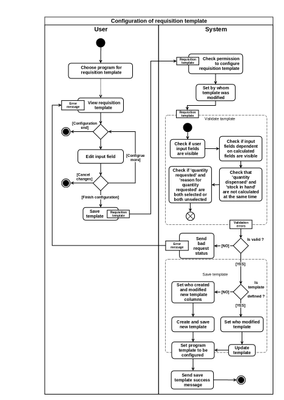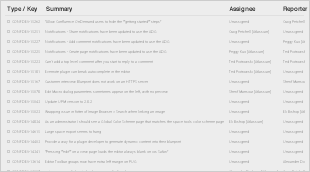|
The options in configuring the Requisition Template, which informs the columns and properties for the requisition form. The requisition form is what end users (storeroom mangers) view and edit in requesting additional stock. We call this the Requisition and Report (R&R) since information is both requested and gathered from the end user. The requisition template is configured by program. The features allow implementers to configure templates to meet the unique programmatic needs.
Implementers are able to:
Each implementation of OpenLMIS configures their requisition templates according to the programmatic needs. There is one requisition template per program. Using the new architecture, implementers can extend the template to meet specific needs for new formulas and options. For example, one example desired extension would be to display values as packs versus dispensing units. Take care configuring the template as many columns are dependent on either user input or reference data.
The following diagram displays the dependencies between the various column headers in the Requisition template. It also was used to discuss the proposed changes for 3.0 (in green). Once all the changes are implemented we will update this to reflect the final state. Please review the legend on the right for information on the colors.

Work in progress.
2.0 activity diagram between User and System



Below is a list of questions to be addressed
Question | Outcome | Status | |
|---|---|---|---|
| 1 | Is M = Number of months in previous period or current period? | based on a call with Josh Zamor & Chongsun Ahn (Unlicensed) on M = number of months in the previous period | Closed |
| 2 | What if X is 31? | based on a call with Josh Zamor & Chongsun Ahn (Unlicensed) on formula would treat a 31 like a 30 (full month out of stock) | Closed |
| 3 | Should we continue to support Monthly Normalized Consumption or should we support a generic Adjusted Consumption which is flexible to varies period lengths? | Based on call with Product Committee on we decided to support adjusted consumption. | Closed |
| 4 | What about supporting Average Adjusted Consumption versus Average Monthly Consumption? Average Adjusted Consumption would support AMC if the implementer is implementing a monthly reorder schedule. | Based on call with Product Committee on we decided to support average adjusted consumption. | Closed |
| 5 | Malawi may need the max stock column to come from 'normalized consumption' versus AMC? Can we make an extension so that you can modify P to be N? | Based on call with Product Committee on we decided to create an extension point so that implementers could multiply by either P or another variable. | Closed |
| 6 | Should we change the name of MaxMonthsStock to infer more of a term which means "multiplier" to clarify that it doesn't have to be 'months' but can be? | Based on call with Product Committee on we decided to rename the field so that months isn't implicit in the attribute | Closed |
| 7 | No of New Patients, can someone explain why this variable is within consumption versus having a separate column? Potentially we could create a new column for this and incorporate it into 're-order calculation' based on the appropriate scenario. | Based on call with Product Committee on we decided to pull out the No of New Patients variable from "N" calculation, unless Ashraf Islam (Unlicensed) and team find something in the SOPs around needing these two combined and included in AMC. | Pending final confirmation from Ashraf Islam (Unlicensed) |
| 8 | What about migration from 2.0? Moving forward with the new columns, what's the mitigation plan? Need to ensure this is part of the gap analysis work. | Open, Need to raise with PC and gap analysis team |
When OpenLMIS was implemented as eLMIS, the teams hard coded in new options to meet country needs. Below is the list of variants completed and why they were created.
| Variable | Title | Options created | Details and comments. Comments in Blue are from Elias Muluneh |
|---|---|---|---|
H | Maximum Stock Quantity | Period Normalized Consumption x 2 | Allowed the maximum stock quantity to take the Period Normalized Consumption into account. |
Dispensed Quantity x 2 | Dispensed quantity = Total Consumed Quantity "C" | ||
N | Monthly Normalized Consumption | Dispensed Quantity x No of New Patients (F) | Dispensed quantity = Total Consumed Quantity "C"
|
(Dispensed Quantity x 90) / (90 - Stock out Days ) | Dispensed quantity = Total Consumed Quantity "C" |
